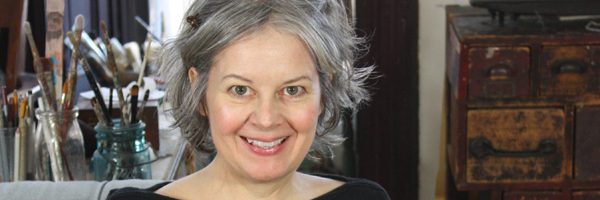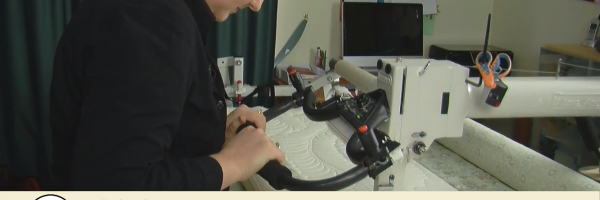
Designer profile with quilter Hope Johnson
Hope Johnson, of Vermont Quilt Bee, brings her love of nature to every quilt she makes. Caroline Adams finds out more
There is always that special something that inspires us to create a quilt. Perhaps it’s the way colours work together, or the print on the fabric that calls to you. In Hope Johnson’s case, nature, and in particular bees, are her constant inspiration.
Hope is not a stranger to being creative or using natural mediums. When she was just seven years old, her father, who was a woodwork teacher, in addition to ceramics, painting and drawing, showed
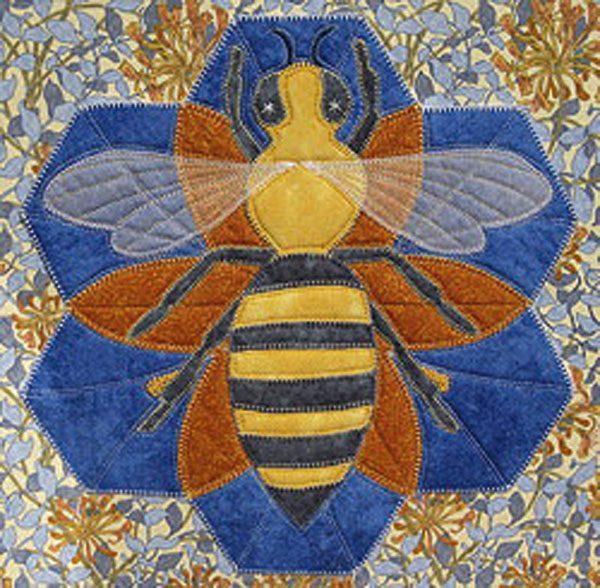
Hope how to use the jigsaw. “I was encouraged by both of my parents to create, relying on my own ideas and using different mediums. So I have done custom work in decorative painting, including furniture and murals; sculpted papier-mâché masks and marionettes; designed and constructed costumes; sewn clothing, pillows and curtains; and designed computer graphics throughout my life.” This led Hope Johnson to becoming a certified art teacher, exposing herself to studio work in metal jewellery making, photography, ceramics, graphic design, sculpture, painting, fibre and colour theory.
Hope’s mother, also an art teacher, taught her how to hand sew when she was about eight years old and gave her patterns to make felt ornaments and cloth animals. However, Hope Johnson’s path to quilting began on a trip to Nova Scotia in 1983, where she saw a “crazy quilt hanging in a folk art exhibit and I was immediately attracted to and transfixed by the colourful and textural details of the embroidery and varied fabric pieces of velvet, silk and cotton. After seeing it I was motivated to learn how to quilt.” So the next year she began an adult school beginner’s hand quilting class where she made a two-block wall hanging.
Create your honey inspired Honeycomb quilt By Keryn Emmerson
One of the blocks was the traditional honeybee made up of squares and ovals and she remembers thinking, “Why not make a honeybee quilt using hexagons?” This led Hope to making the quilt, Honey, I’m Home, which was her first bed-size quilt made entirely by hand. And so began her love of quilting, inspired by nature.
“My quilt making is mainly influenced by my interest in patterns in nature. For instance, the Hive in Winter quilt was an attempt to show the shared hexagonal geometry of the snowflake, daylily and honeycomb. An idea for a quilt can be triggered by a discussion with a beekeeper regarding the honeybees’ “waggle dance” or something as simple as a swatch of fabric,” says Hope.
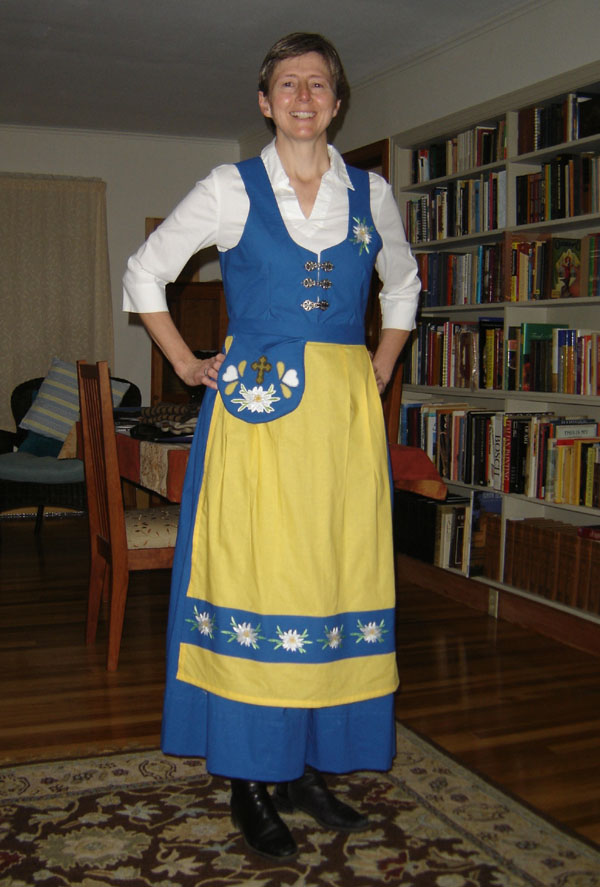
“I am very deliberate with my creative process in that I will research a concept or idea, render an edited design, measure and calculate the dimensions of hand-drafted pieces and pour over colour options. Through the whole design process, I stay open to changing and adapting the pattern so that, in the end, the quilt design will have visual integrity and balance as well as successfully represent the original concept.”
Hope Johnson now lives in the town of Shelburne, Vermont, USA, very close to the east shore of Lake Champlain. In 1994, on a visit with a friend to Burlington, Vermont, she was impressed by the stunning beauty of the lake and the Champlain Valley.
Make your own Rolling along quilt By Pam McMahon
When making changes to her life in New Jersey in 1995, she took a leap of faith and began running a bed and breakfast on her own in Burlington, Vermont. She purchased a big, old Victorian house which she renovated and turned into an inn. For three years, between changing sheets, dusting furniture and cleaning bathrooms, she still found time to quilt.
In this move, Hope Johnson found more inspiration from nature and an increasing affinity with bees. “My creative collaboration with the beekeeping community has opened up a world of art and science to me,” she says. “I met Dr. Diana Sammatoro, retired USDA bee researcher and quilter, at the 2014 Eastern Apicultural Society (EAS) Conference in Richmond, Kentucky.
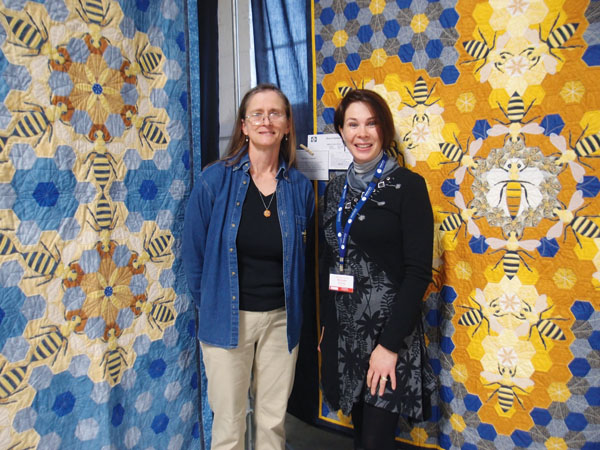
We got talking about the current plight of the honeybee and I mentioned the idea of making a community quilt to raise funds for honeybee research. Diana suggested that a worthy recipient of funds would be the non-profit Bees for Development (BfD), UK, that provides beekeeping training and marketing of related products to enable poor communities to develop sustainable income and improve their standard of living.”
Hope and Diana set about making the project a joint effort of the Champlain Valley Quilters Guild of Vermont and Diana’s guild, the Tucson Quilters Guild in Arizona. More than 75 quilters submitted appliquéd and embroidered sunflowers that Hope Johnson arranged in a spiral pattern with a worker bee appliqué in the centre. The BfD Sunflower Quilt made its public debut at the 2015 EAS Conference in Guelph, Ontario, and two beekeepers from Rhode Island made a donation of USD$2700 to be applied to BfD’s beekeeping centre in Ethiopia. The words of Evelyn George, Member-At-Large of Tucson Quilters Guild, were especially meaningful when she said, “Bees are very special to us quilters as symbols of working together for betterment of the community.
Create your own Maggies baskets quilt By Sharon Keightley
My personal creative journey has led to connections of which I never would have imagined. If my art can make a positive difference, to help sustain as well as inspire others, then I can’t think of a more meaningful and gratifying reason for my creative work. Just as the working beehive is the result of the coordinated contributions of many, so we can all make a positive difference in our communities, and the world, when we combine our creative efforts.”
And from Hope: “I am also influenced by, and indebted to, the feedback, advice and sewing help from my quilting buddies and fellow quilt guild members. I consider Vermont Quilt Bee as inclusive of the collaboration and mutual support that I share with my husband, friends, quilters and beekeepers.”
Hope’s bee-inspired series of quilts has a strong use of the hexagon shape and blue and gold colour themes. And the reason is simply that yellow-orange and blue hues are complementary colours and vibrant when used together. “I also like to use colours reminiscent of honey which can vary from light yellows to amber to golden brown. The honeycomb is one of nature’s architectural marvels and constructed of two layers of hexagonal cells so I use the symmetrical hexagon in all of the bee quilts,” explains Hope Johnson so succinctly.
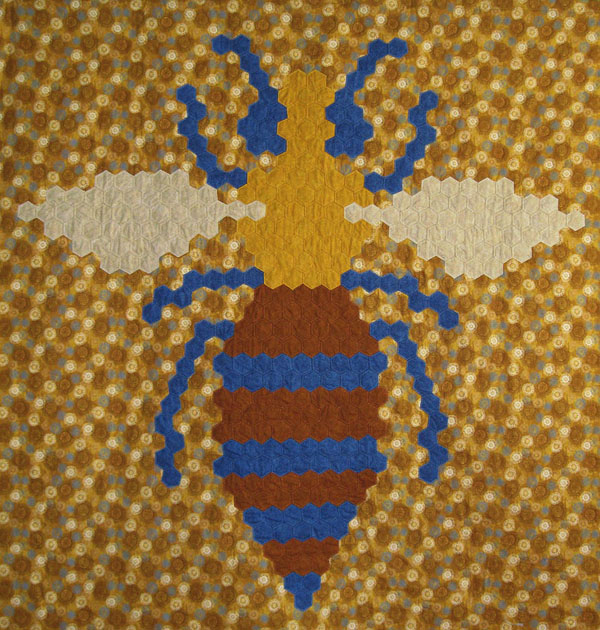
Hope started quilting by hand and, “if I had nine lives, I would continue to do so! I mostly machine piece and quilt, adding details with hand embroidery; French knots are pollen grains on the legs of honeybees.”
In Wool Bees, Hope challenged herself to make the quilt entirely of wool. Wool fabric from vintage wool skirts and pants were used to make the top; the backing is an old wool baby blanket; the bees are embroidered using wool tapestry rug yarn; and the machine quilt stitches were made with Madeira wool thread. Sadly, Hope has found she is allergic to wool, so she now prefers to work with cotton, silk, and poly/cotton blends.
Hope also works with the “Patriotic Spirits” group of quilters, using more traditional patterns when making quilts that are donated to wounded veterans through the Quilts of Valor program. She also tells us of her garment sewing experience when her sister, Barbara, called her to say she needed a traditional Swedish folk dress (with embroidery) for a St. Lucia Festival happening in three days! “So she and I bought the fabric on Friday and holed up in my studio for two days when all we did was sew, eat, go to the bathroom and sleep — in that order. The dress was finished by Sunday morning in time for the festival that evening. Sisterhood is powerful!”
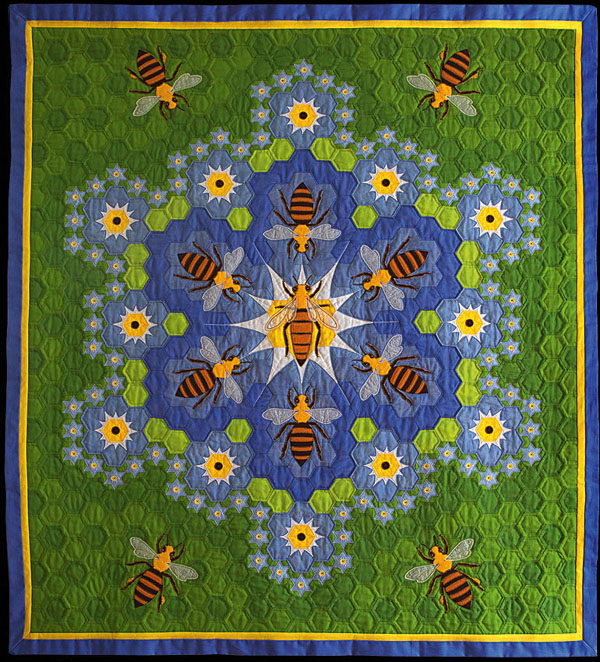
Currently Hope Johnson is working on two quilts. In The Hive in Autumn, the fourth and last in a series of seasonal beehive quilts, the colour palette has been expanded to include green and red-orange. And in response to the recent American presidential campaign and election, Hope Johnson was inspired to make a patriotic, populist, pussycat quilt, Puss in Boots, a tribute to the contribution of working women in the agricultural sector and the trades. Both of these quilts will be shown at the 2017 Vermont Quilt Festival in June.
When Hope shows her work at local events, she loves to pass on her knowledge by running art classes for children that I call “Honeybee Geometry”. Students construct three-dimensional hive forms and learn to make and design patterns with hexagon templates. You can also find her at the regional guild show, demonstrating hexagon piecing and design or giving talks to community groups on craft and community.
Hope invites everyone to “take the time to see nature up close. In the smallest of creatures and plants, there is beauty and intricacy as well as a bottomless well of creative inspiration!”
You can find Hope Johnson at
Website: vermontquiltbee.com,
Email: vermontquiltbee@gmail.com

